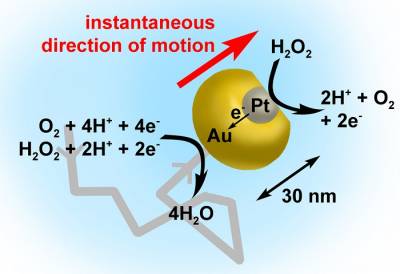Motility is considered an important characteristic of life. Inspired by nature, my group is designing and making nanoparticles that are capable of self-propelling in liquid media.
These active nanoparticles, also known as nanomotors, are expected not only to have critical implications in the understanding of nonequilibrium dynamics of living systems, but also to shed light on their applications as active delivery systems of drugs or tetherless nano-tools for minimally invasive surgery.
| Fig 1. A schematic diagram of a self-propulsion mechanism, known as self-electrophoresis, of a nanomotor, in this case a 30-nm Pt-Au Janus nanoparticle. The nanomotors can self-propel in water in the presence of H2O2 fuel at a record speed of ~2.2×104 body lengths per second. [Nano Lett. 2014] |
 |
Recent Publications
- Tung-Chun Lee, Mariana Alarcón-Correa, Cornelia Miksch, Kersten Hahn, John G. Gibbs, and Peer Fischer, "Self-propelling nanomotors in the presence of strong Brownian forces", Nano Lett., 2014, 14, 2407-2412
- Tian Qiu, Tung-Chun Lee, Andrew G. Mark, Konstantin I. Morozov, Raphael Münster, Otto Mierka, Stefan Turek, Alexander M. Leshansky, and Peer Fischer, "Swimming by reciprocal motion at low Reynolds number", Nat. Commun., 2014, 5: 5119
 Close
Close

